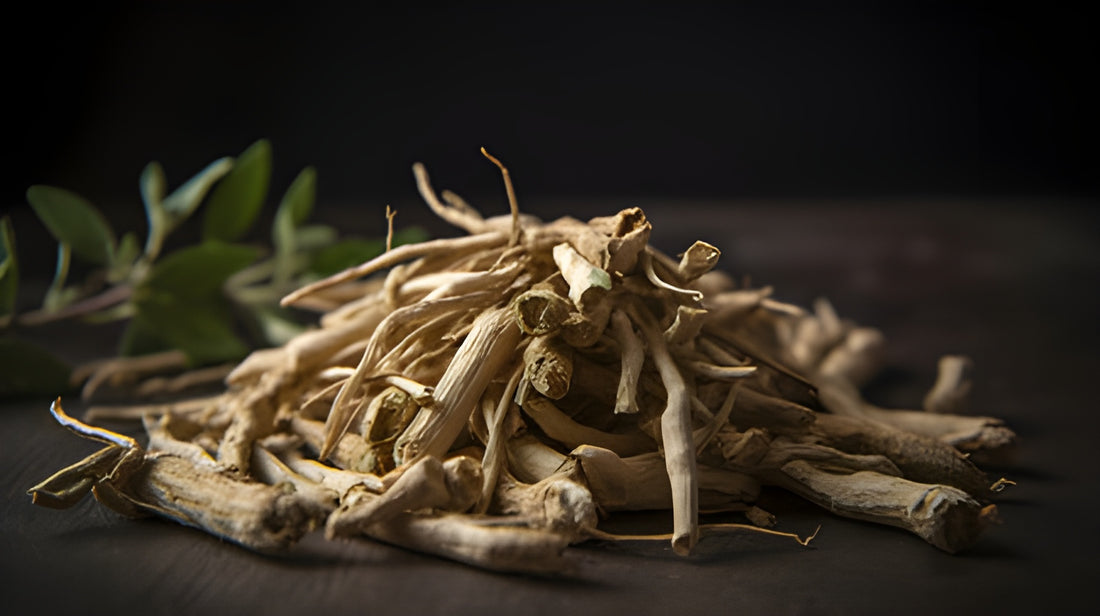Ashwagandha: An Effective Adaptogen

Nutriventia
Ashwagandha, known as "Indian ginseng" or "Indian winter cherry," is a revered herb in traditional medicine, celebrated for its extensive health benefits. It is an adaptogen that helps the body enhance body adaptation to stress, improve sleep quality, support physical stamina, and support nervous system as traditionally used in Ayuverdic medicine. Ashwagandha is also known for its ability to boost energy, muscle strength, and increse overall vitality. This powerful herb is well-regarded for its minimal side effects, making it a valuable addition to your wellness routine.
Ashwagandha
Ashwagandha (Withania somnifera fam. Solanaceae) also known as “Indian winter cherry”, “Indian ginseng”, “Punir” or Asgandh is one of the most revered herbs in Ayurveda1. It originates in the Mediterranean region of North Africa, North western and Central India, and Central Asia2. Its orange-to-red fruit and roots have been utilized for therapeutic purposes for hundreds of years. The Ayurvedic, Siddha, and Unani systems prepare more than 200 traditional medical formulations with ashwagandha3,4. The plant has been extensively used for more than 5000 years and is also designated as “Sattvic Kapha Rasayana” which serves as a health promoter, rejuvenator as well as a tonic5. The plant derives its name from two words : ‘ashwa’ meaning horse and ‘gandha’ meaning fragrance which literally means a horse-like scent. Also it possesses an the ability to impart strength and vigor like a horse 3,4.
It thrives in semi-tropical regions with 600-700 mm of annual rainfall and is able to withstand temperatures between 10 – 38oC. It requires sandy loam or light red soils with a pH between 7.5-8.0. The crop is sown between July and August and the growing period is for 150-170 days long. It is harvested between January – March, a crop is considered mature when the berries turn yellow red and the leaves begin to dry. The stem is sliced 1–2 cm above the crown roots to separate the roots from the aerial sections. The lateral rootlets are broken off, and soil adhering to the roots is removed by clubbing the roots which are then cleaned and dried in the sun or in a shed until they retain only 10–12% moisture. These are then transversely crosswise into 7–10 cm pieces and then sorted according to market demand2.
Ancient texts note that the roots are used for internal consumption whereas leaves are only for topical use. The roots contain the most powerful and plentiful active molecules (steroidal lactones such as withanolides, alkaloids, saponins) however, due to a sharp rise in the demands for ashwagandha led to some companies adding leaves to some companies adding leaves to the roots of ashwagandha5,6. Leaf extracts are seen to contain the cytotoxic withaferin A at high levels, which root extracts have a comparably low levels. Therefore, it is recommended to avoid using leaf extracts7.
In Canada, ashwagandha root is listed as an active ingredient in the national database of approved natural health products while the European Food Safety Authority (EFSA) is currently studying some 15 pending health claims for ashwagandha root. European Medicines Agency (EMA) has an ongoing case making a monograph for Withania somnifera. Official pharmacopoeia recommendations around the world, including those of the United States, Britain and India (API Part I, Vol. I), and the World Health Organization’s monograph for ashwagandha list only the properties of the root6. In October 2021, India’s ministry of AYUSH released a statement that advised against the use of ashwagandha leaves in Ayurveda and products for therapeutic purposes7.
Research shows that the total alkaloid content in Indian ashwagandha roots varies from 0.13-0.31%. The commercial value of ashwagandha roots depends on their physical quality and morphology. Those that are brittle, robust and lengthy have a higher market value5.
- Singh N, Bhalla M, de Jager P, Gilca M. An overview on ashwagandha: a Rasayana (rejuvenator) of Ayurveda. Afr J Tradit Complement Altern Med. 2011 ; 8(5 Suppl) : 208 - 13. doi: 10.4314/ajtcam.v8i5S.9.
- Kumar A, Venugopal S, Jnanesha A, Lal R. Agricultural-based challenges, genetic enhancement, and obstacles to an industrially important medicinal plant, ashwagandha (Withania somnifera (L.) Dunal) : a review. Ecol Genet Genom. 2023 ; 28 : 100183. https://doi.org/10.1016/j.egg.2023.100183
- Mikulska P, Malinowska M, Ignacyk M, Szustowski P, Nowak J, Pesta K, et al. Ashwagandha (Withania somnifera)-Current Research on the Health-Promoting Activities: A Narrative Review. Pharmaceutics. 2023 ; 15 (4) : 1057. doi: 10.3390/pharmaceutics15041057.
- https://atlasbars.com/blogs/ashwagandha-explained/the-ancient-history-of-ashwagandha-a-herb-that-stood-the-test-of-time
- Khabiya R, Choudhary G, Jnanesha A, Kumar A, Lal R. An insight into the potential varieties of ashwagandha (Indian ginseng) for better therapeutic efficacy. Ecol Front. 2024 ; 44 (3) : 444-450
- https://insights.figlobal.com/ksm-66/importance-using-only-root-part-ashwagandha-your-product
- https://www.nutraingredients-asia.com/Article/2021/10/25/Shakeup-in-ashwagandha-sector-India-s-AYUSH-caution-against-use-of-leaves-in-supplements
- Verma S, Kumar A. Therapeutic uses of Withania somnifera (ashwagandha) with a note on withanolides and its pharmacological actions. Asian J Pharm Clin Res. 2011 ; 4 (1) : 1-4
- https://www.kamaayurveda.in/blog/ashwagandha-benefits
- https://ods.od.nih.gov/factsheets/Ashwagandha-HealthProfessional/
- Arora S, Samanta K, Chettri S, Rawat D, Percha V, Kumar D. Ashwagandha: A Flagship Herb of Ayurveda from Past to Present Nano Era. Int J Pharm Invest. 2023 ;13 (3) : 393–401. https://doi.org/10.5530/ijpi.13.3.050



